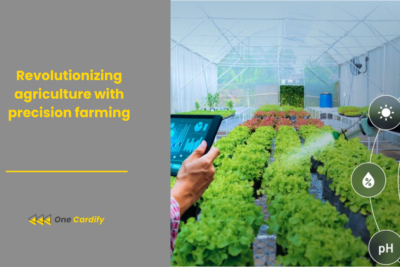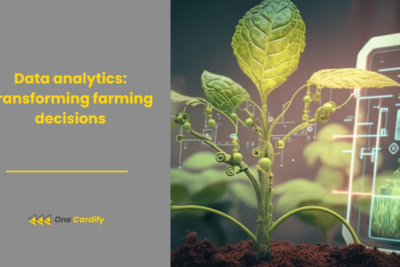
CRISPR and the future of food security
CRISPR technology has ushered in a new era in agricultural science, representing a huge leap in our push for food security. With the increase in the global population, the problem of feeding everyone becomes more complicated. Yet, CRISPR is the answer to achieving yield enhancements, disease resistance, and climate adaptability in crops.In this blog post, we will consider the CRISPR implications on the future food production, looking into the advantages, as well as the ethical considerations, associated with CRISPR. In our passage through the crossroad of genetic editing and agriculture we will bring to the fore how this revolutionary technology will define tomorrow’s sustenance.At a period when food security is more demanding that it ever has been, the part CRISPR has to play in developing resilient and sustainable food systems cannot be underrated. Walk with us as we look at how this pioneering technology is pushing the limits of what can be done in agricultural innovation.
Understanding CRISPR and Its Impact on Agriculture
CRISPR is an innovative gene-editing technology that can bring a revolutionary change in agricultural science. Through accurate manipulation of plants’ DNA, scientists can improve traits like productivity, nutritional value, and resistance to pests and diseases. The precision and the efficiency is one of the most crucial benefits of CRISPR, and they result in the development of crops that can tolerate changing climatic conditions. This is important for global food security under challenges like higher temperatures, irregular rainfall, and the spread of plant pathogens.This technology also holds out the hope of limiting the ecological impact of farming practices, to the extent where a lot of crops are developed that require minimum chemical inputs, for example, pesticides and fertilizers. This not only is good for the ecosystem but also helps in the sustainability of agricultural systems around the world.Although being a very prospective technology, the use of CRISPR in agriculture brings up ethical and safety issues. Engineering genetic material of crops calls for thorough testing for these modifications not to have negative impacts on people’s health and environment.
Related content
Related content
CRISPR: A Tool for Enhancing Food Nutrition and Quality
Apart from yield and disease resistance, CRISPR technology has the ability to improve the nutritional content of food crops. Biofortification which is the improvement of food crops nutritional value through genetic modifications is a good approach of dealing with the world nutritional problems.CRISPR can assist in modifying crops to have higher contents of vitamins, minerals, and essential amino acids. This has far-reaching consequences in the efforts to eliminate malnutrition or promote a healthier global population.This technology also makes it possible to grow the crops with the better taste, texture, and shelf-life, which is important for the reduction of food waste and the availability of the high-quality food.However, while this is advantageous, CRISPR used to enhance food nutritional value and quality encounters intricate regulatory frameworks and GMO public perceptions.
Tackling Climate Change with CRISPR-Enhanced Crops
With climate change becoming a bigger threat to food security, CRISPR offers a ray of hope. Genetic modification of crop’s genomic set can enable scientists to breed varieties that perform well under severe weather conditions such as drought, flooding, and salinity.Such climate-resilient crops can sustain stable food production in an uncertain weather pattern and thereby protect future generations of food supplies. The genetic breeding of crops which are highly water and nutrient use efficient also contribute to sustainable agricultural practices, thereby minimizing the pressure on natural resources.Nevertheless, the employment of CRISPR technology in addressing climate change needs worldwide cooperation and knowledge sharing to make the benefits accessible to all, particularly those in developing nations that are most susceptible to food insecurity.
CRISPR and the Future of Food Security: Challenges and Opportunities
The application of CRISPR technology in agriculture is a great breakthrough in food security. It has a capacity of making a change in food production by developing crops that are more nutritious, resistant, and environmentally friendly.However, unlocking this potential will have its challenges, among them include ethical concerns, regulatory obstacles, and public acceptance of genetically modified crops. Going forward, a balanced approach that looks at the scientific benefits and societal values will be crucial.The path of incorporating CRISPR into our food systems has only just started. As the research advances and the technology becomes mature, the coming decades are expected to see a major change in the process of production and consumption of our food.
Conclusion
The CRISPR technology is a new approach to agricultural science, which addresses many problems of food security with various innovations. The potential to modify the genetic information of plants with unparalleled accuracy offers a great hope of strengthening our food systems in terms of resilience, nutrition, and sustainability.Nevertheless, the way ahead is riddled with hurdles, which will call for the weighing of ethical, regulatory and societal acceptance issues. However, the promise of CRISPR in the world of hunger and malnutrition free future cannot be denied.Stepping into this genetic revolution, it is apparent that the CRISPR technology might be the cornerstone of a new food production era, which is able to feed the needs of a growing global population fairly and sustainably.
CRISPR is a groundbreaking gene-editing technology that allows for precise alterations to the DNA of organisms, including plants, to improve traits such as yield, disease resistance, and nutritional content.
CRISPR benefits agriculture by enabling the development of crops that are more resilient, nutritious, and environmentally sustainable, promising enhancements in food security and quality.
The primary ethical concerns involve the manipulation of genetic material, potential unintended effects on human health and ecosystems, and issues related to GMO acceptance and regulatory oversight.
Yes, by enabling biofortification, CRISPR can increase the nutritional value of crops, offering a potent tool against global nutritional deficiencies.
CRISPR can develop climate-resilient crops that withstand extreme weather, offering a critical solution to ensuring stable food production in the face of climate change.
Challenges include ethical and safety concerns, regulatory barriers, and the need for public acceptance of genetically edited crops.
The future promises crops with enhanced resilience, nutrition, and environmental sustainability, though realizing this potential will require addressing ethical, regulatory, and societal challenges.
Moving Forward
While we begin this exploration of where agriculture is heading, it is important to welcome the opportunities that CRISPR technology opens to us. The possibility of an earth in which every person may consume healthy, renewable food is within our reach.Nevertheless, realizing this dream will call for the partnership of scientists, policy-makers, and the public to overcome the obstacles facing us. With CRISPR, we can achieve the power that we desire to unleash a brilliant future in the global food security.We should go down cautiously but bravely into this new era aware of the challenges it brings and with hope that it will enable to feed the world.Continued research and open communication can make the dream of eliminating hunger and malnutrition possible as a result of the wonderful developments of CRISPR technology.






Related Posts